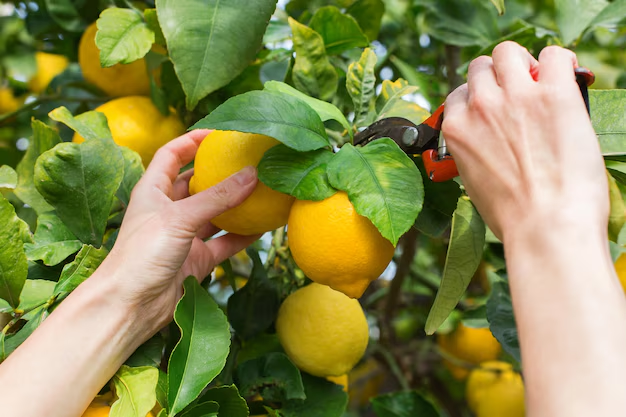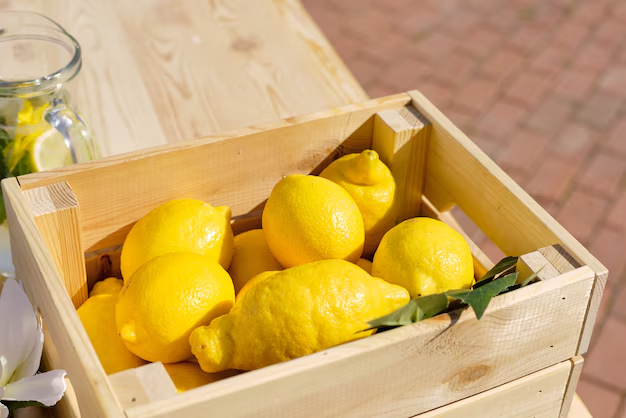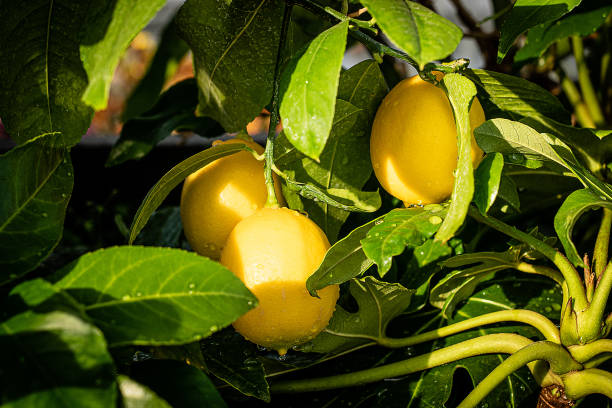Lemon trees are not just productive; they’re a staple in many New Zealand gardens, heralding the sunny days with their vivid color and refreshing scent. Whether you’re a seasoned gardener or a budding green thumb, this article will help you optimize your lemon-growing efforts to make the most of lemon season NZ.
When is Lemon Season in NZ?
Although the lemon season in New Zealand usually reaches its peak from early winter till the end of summer, certain types can yield fruit all year round if given proper attention.
Meyer Lemon
New Zealanders favor Meyer Lemon due to its deliciously sweet and less acidic flavor, making it a sought-after option for both cooking and ornamental purposes. What makes this type stand out is its resilience to diverse weather climates throughout the country.
- Description: Meyer Lemons can be recognized by their sleek and slim skins, which have a subtle orange hue when they are fully ripe.
- Season: Throughout the year, they yield fruit frequently with greater harvests during warmer months.
- Uses: This variety of lemon is perfect for creating desserts, beverages and lemon curd thanks to its gentle acidity and fragrant zest.
Lisbon Lemon
Traditional and tart, Lisbon Lemons are extremely popular in New Zealand due to their strong taste and ability to be used in a variety of culinary settings. Flourishing best in cooler temperatures, these lemons are regularly grown in regions with varying climate conditions, making them an ideal choice for many growers.
- Description: Lisbon Lemons are distinguished for their textured skins and abundance of juicy pulp.
- Season: The season for harvesting is mainly during the warmer months, spanning from late spring to early autumn.
- Uses: Frequently employed as an ingredient in culinary recipes, baking procedures, food preservation techniques and for imparting a distinctive taste to sauces and marinades.
Yen Ben
Yen Ben Lemons are descendants of the Lisbon lemon, known for their high quality and adaptability to New Zealand’s diverse climate conditions. This variety is favored for its consistent fruit production and reliable performance across different regions.
- Description: Yen Ben Lemons typically have a medium-thick skin and a balanced ratio of acidity to sweetness.
- Season: Harvested from late winter through early summer, with peak yields in spring.
- Uses: Suitable for fresh consumption, juicing, and various culinary applications, including salads, marinades, and beverages.
How to Grow Lemons in New Zealand

Growing lemons in New Zealand requires careful consideration of site selection, planting techniques, and ongoing care to ensure healthy trees and abundant fruit production. Here’s a detailed guide to help you get started:
Choosing the Right Site
When planting lemon trees in New Zealand, selecting the optimal site is crucial for their growth and productivity.
- Sunlight: Lemon trees require a minimum of six hours of direct sunlight daily to thrive and produce fruit.
- Soil: Opt for well-draining soil with a pH level between 6.0 and 7.5, which supports nutrient uptake and healthy root development.
- Protection: Choose a location sheltered from strong winds to prevent damage to branches and fruit.
Planting Your Lemon Tree
Proper planting techniques are essential to ensure your lemon tree establishes well in its new environment.
- Plant your lemon tree in spring or early summer to allow it to establish roots before the onset of colder weather.
- Dig a hole twice as wide and just as deep as the root ball of the tree.
- Mix compost with the native soil at a 50:50 ratio to improve soil structure and nutrient content.
- Position the tree in the hole so that the base of the trunk is level with the surrounding soil.
- Backfill the hole carefully, gently tamping down the soil to remove air pockets.
- Water the tree thoroughly immediately after planting to settle the soil around the roots.
Ongoing Care
Regular maintenance ensures your lemon tree remains healthy and productive over the years.
- Watering: Provide regular waterings, allowing the soil to dry slightly between watering sessions to avoid waterlogging.
- Feeding: Use a nitrogen-rich fertilizer every other month during the growing season (spring to autumn) to promote vigorous growth and fruit production.
- Pruning: Prune your lemon tree in late winter to remove dead or crossing branches and to shape the tree for better air circulation and sunlight penetration.
Pest and Disease Management
Vigilance against pests and diseases is essential for maintaining the health of your lemon tree.
- Common Pests: Watch for pests such as aphids, scale insects, and citrus mites, which can damage leaves and fruit.
- Disease Prevention: Monitor for signs of fungal diseases like greasy spot and citrus canker, ensuring early intervention with appropriate fungicides if necessary.
Harvesting and Using Your Lemons

Successfully growing and utilizing lemons in New Zealand involves understanding optimal harvesting techniques, storage methods, and versatile uses in culinary and household applications. Here’s a detailed guide to help you make the most of your lemon harvest:
Best Practices
Knowing when and how to harvest your lemons ensures optimal flavor and quality.
- When to Harvest: Lemons are ready for harvest when they reach full color (typically bright yellow) and feel slightly soft when gently squeezed.
- How to Harvest: Use sharp secateurs or pruning shears to cut lemons from the tree, avoiding pulling or twisting which can damage branches and affect future fruiting.
Storing Lemons
Proper storage methods help maintain the freshness and flavor of harvested lemons.
- Room Temperature: If you plan to use lemons within a week, store them at room temperature away from direct sunlight.
- Refrigeration: For longer storage, place lemons in the refrigerator’s vegetable drawer where they can stay fresh for up to a month.
Uses of Lemons
Lemons offer diverse applications beyond culinary uses, contributing to health and household cleaning.
- Culinary Uses: Lemons are prized for their versatile culinary applications, enhancing dishes from salads to desserts with their tangy zest and juice.
- Health Benefits: Rich in vitamin C, lemons support immune health and can be consumed in drinks or dishes to boost nutritional intake.
- Cleaning Agent: Lemon juice serves as a natural cleaner due to its acidity, effectively cutting through grease, disinfecting surfaces, and removing stains.
Budgeting for Your Lemon Tree
The initial cost of a lemon tree in New Zealand can range from $25 to $50 for a young tree. Additional costs include soil amendments, fertilizer, and potential pest treatments. Annually, you might spend approximately $100 to maintain a healthy lemon tree, considering water, fertilizer, and other care.
Conclusion
With this guide, you’re equipped to dive into lemon season NZ with confidence. Enjoy the zestful journey of growing your own lemons and relish the fruit of your labors!
FAQ
A: Yes, lemons can grow very well in pots, especially varieties like Meyer lemon. Make sure the pot is large enough and has good drainage.
A: Typically, lemon trees will start to bear fruit in 3 to 5 years after planting, depending on the variety and conditions.
A: No, lemon trees are self-fertile and do not require a pollinator to produce fruit.
A: Ensure it’s getting enough sun, water, and fertilizer. Pruning correctly and managing pests and diseases are also crucial for good fruit production.
A: In colder areas, protect your lemon tree with frost cloths or move potted trees indoors if possible during frosty nights.
